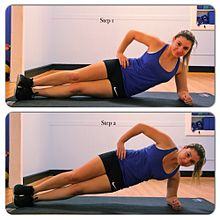User:Jaykayfit/sandbox
Prevention[edit]
Although there are not many ways to completely prevent spondylolisthesis from occurring, there are ways that may decrease the opportunity for it to develop. As we get older, we tend to lose proper posture; this is a result of our body compensating to stand up straight, which then may lead to a slouching habit. Posture we age, we progressively lose fluid in our spine and our vertebra loses some mineral content. Proper posture is one of the ways to avoid symptoms associated with spondylolisthesis [1]
Spondylolysis and spondylolisthesis: prevalence and association with low back pain in the adult community-based population. Spine [2]. A strong core is one of the major components of preventing back pain and injury [3]. Strengthening your abdominal muscles is vital in preventing the possibility of injuries later on in life. Figure 1,2, and 3 demonstrate a few core exercises.
Various activities and sports such as gymnastics, diving, football, and weight lifting are known to increase stress on the vertebrae. Using weight lifting as an example, it is important to lift with your lower body to relieve any stress on your back, which if done incorrectly, can shift vertebrae placement. Improper form will cause serious injury with any of the mentioned activities, which then may lead to the development of spondylolisthesis [4](Hicks, 2005)). If an individual has already been diagnosed with spondylolisthesis they need to take the proper precautions, especially with high intensity sports in order to prevent worsening of the condition. Correct form and core strengthening should become habitual in order to counteract the development of spondylolisthesis.
Besides avoiding high intensity exercises in general, there are other various strategies in preventing or treating spondylolisthesis. It is crucial to maintain a healthy body weight, eat well, and exercises regularly [5]. These lifestyle choices not only lead to a healthier lifestyle, but they also promote proper blood flow throughout the body, delivering nutrients and oxygen to needed areas. Aerobic exercises such as walking, swimming, yoga, and biking are most beneficial [6]. Any individual looking to begin these exercises or any kind of therapy should consult a physician to gain a better understanding of what is suggested for their particular situation. Spondylolisthesis might not be completely preventable, but by taking proper precaution we can help reduce the risk of it from developing or worsening.



- ^ Kalichman L, Kim DH, Li L, Guermazi A, Berkin V, Hunter DJ.
- ^ (Phila Pa 1976) 2009;34:199–205.
- ^ Wiltse LL, Newman PH, Macnab I (1976) Classification of spondylolisis and Spondylolisthesis. Clin Orthop Relat Res 23–294
- ^ Hicks GE, Simonsick EM, Harris TB, Newman AB, Weiner DK, Nevitt MA, Tylavsky FA. Trunk muscle composition as a predictor of reduced functional capacity in the health, aging and body composition study: the moderating role of back pain. J Gerontol A Biol Sci Med Sci. 2005;60:1420–1424.
- ^ Mihara, H. "The biomechanical effects of spondylolysis and its treatment." Spine 28.3 (2003): 235-8
- ^ Marchetti PG, Bartolozzi P. Classification of spondylolisthesis as a guideline for treatment. In: Bridwell KH, Dewald RL, Hammerberg KW et al, editors. Textbook of Spinal Surgery, 2nd edn. Philadelphia: Lippincot-Raven; 1997. 1932:54:371

